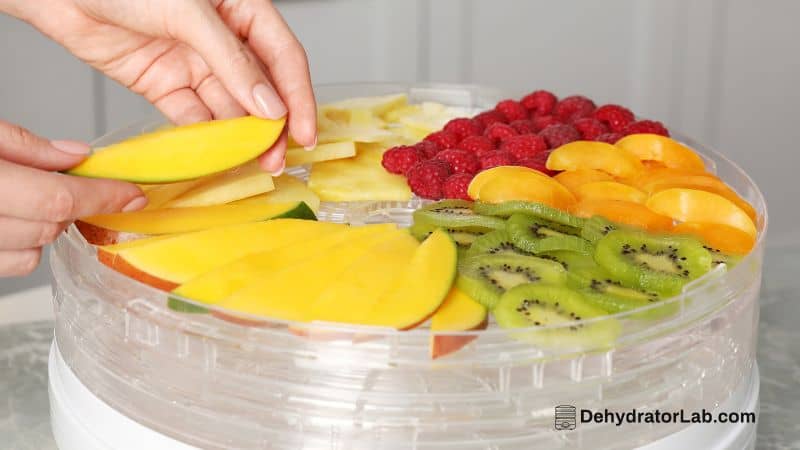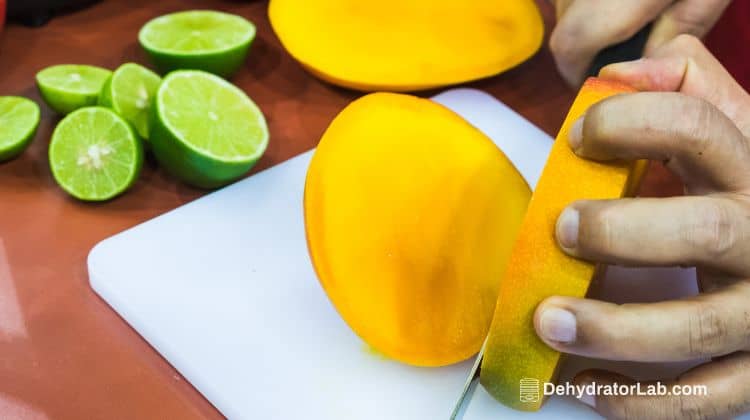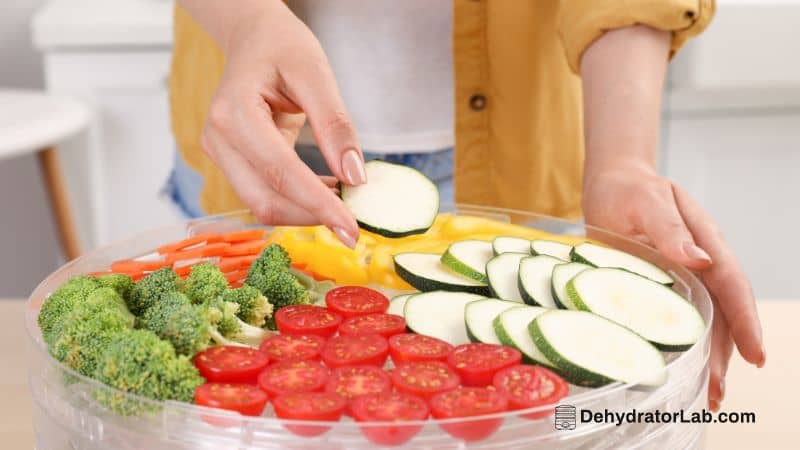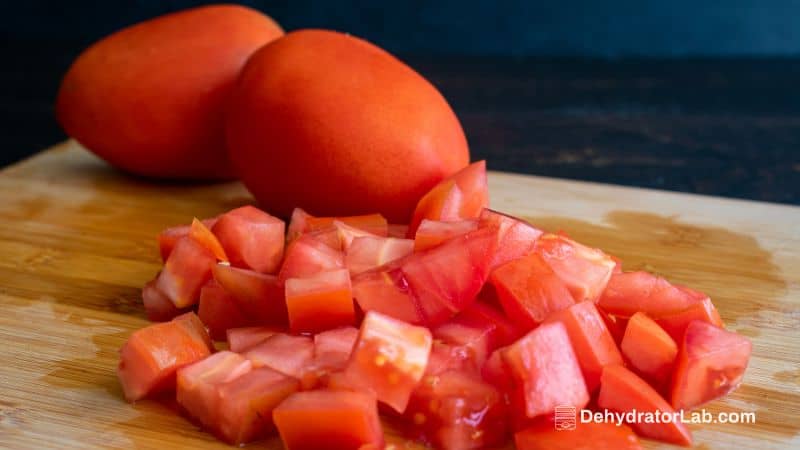Dehydrating mangoes is a simple yet rewarding process. The result is a delicious and healthy snack perfect for satisfying a sweet tooth.
This article will guide you on how to dehydrate mango using a food dehydrator, from preparation to storage.

As an Amazon Associate, I earn from qualifying purchases. If you make a purchase after clicking on a link I may earn a small commission at no extra cost to you if items are purchased.
In this article:
Key Points on How to Dehydrate Mango [TL;DR]
🥭 Dehydrated mangoes make for a delicious and healthy snack, perfect for satisfying a sweet tooth.
🔪 Use a vegetable peeler to peel the mango
🧭 Slicing mangoes too thin can result in a brittle texture when dehydrated, so it’s important to find the right thickness for optimal results.
🧺 The Excalibur dehydrator can fit more mangoes than round dehydrators, making it a convenient choice for drying large quantities.
🍍 Dehydrating mangoes at higher temperatures results in a crispy, crunchy texture, while dehydrating at lower temperatures preserves the enzymes and goodness, giving it a gummy bear-like texture.
🕒 Dehydrating mangoes is a simple process that involves setting the time and temperature and letting the dehydrator do its job.
🍓 The optional silicon sheets for the dehydrator are great for fruits and vegetables with higher moisture content, as well as smaller items like berries and herbs.
💦 Dehydrating fruits with higher moisture content or sweetness can be a challenge, but using silicone mats can help overcome this issue.
🌡️ Dehydrating mangos at a lower temperature (around 105 degrees) helps to preserve the enzymes and keep them as a live food.
Dehydrating Mangoes
Dehydrating mangoes involves a few key steps: preparation, loading the dehydrator trays, setting the time and temperature, checking the dehydrated mangoes, and storing them. Each step is crucial to achieving the desired outcome.
Preparation
The preparation process begins with choosing ripe mangoes. The riper the mangoes are when dehydrating, the sweeter they will be, resulting in a higher-quality dried fruit. Ripe mangos are at their peak level of sweetness, which translates well into the dehydrated version.
However, there’s nothing wrong with dehydrating mangos that are about to go bad or need preserving. The rule of thumb is that the quality of what you put in is the quality of what you get out.
Peeling and Cutting Mangoes
The next step is peeling and cutting the mangoes. It’s important to use the right tools for food preparation.

A vegetable peeler is a great tool for peeling mangoes. I use a Titan vegetable peeler. It’s an excellent tool that cuts through everything with ease.
When cutting the mangos, aim to get as close to the pit as possible. The shape doesn’t matter much, as long as the pieces are about a quarter of an inch thick. This thickness ensures that the dehydrated mango has some substance, making it a satisfying snack.
Remember that slicing mangoes too thin can result in a brittle texture when dehydrated. Therefore, it’s important to find the right thickness for optimal results.
Dehydrating Process
The dehydrating process involves loading the dehydrator trays, setting the time and temperature, and letting the dehydrator do its job.
Loading the Dehydrator Trays
Once cut, the mango pieces are placed on the dehydrator trays. In this instance, ten mangos filled almost five Excalibur dehydrator trays. The Excalibur is a fantastic dehydrator due to its large capacity compared to round models.
When loading the dehydrator trays, consider using optional silicon sheets. These are great for fruits and vegetables with higher moisture content, as well as smaller items like berries and herbs.
The Excalibur dehydrator can fit more mangoes than round dehydrators, making it a convenient choice for drying large quantities.
Setting Time and Temperature
The recommended temperature for dehydrating mangoes is around 120 degrees (50 degrees Celsius).
However, dehydrating mangos at a lower temperature, around 105 degrees (40 Celsius) helps to preserve the enzymes and keep it as a live food. This process may take over 24 hours, but the result is worth the wait.
Checking the Dehydrated Mangoes
The ease of peeling the dehydrated mangoes off the tray suggests that they have reached the desired pliable consistency.
Dehydrating mangoes at higher temperatures results in a crispy, crunchy texture, while dehydrating at lower temperatures preserves the enzymes and goodness, giving it a gummy bear-like texture.
The Final Product
After a couple of days, the mangos are fully dehydrated. They were kept at a temperature between 95 and 105 degrees Fahrenheit, resulting in a texture similar to gummy bears. The lower temperature also helps to retain the enzymes and nutrients in the fruit.
Storing Dehydrated Mangoes
Dehydrated mangoes can be stored for several months, making them a convenient and long-lasting snack option.
The dehydrated mangos are then stored in jars with a dry pack to absorb any leftover moisture, preventing any mold issues. The final product is a delicious, mango-flavored treat that’s perfect for satisfying sweet cravings.
Cost Analysis
Making your own dehydrated mangoes can be cost-effective, especially if you have access to fresh mangoes at a reasonable price. The cost of a dehydrator and the electricity used during the dehydrating process should also be factored into the overall cost.
Benefits of Homemade Dehydrated Mangoes
Homemade dehydrated mangoes have several benefits. They are a healthy snack option, free from additives, chemicals, and preservatives.
As one of our editors said, “It’s just mangoes. There’s nothing else in here. There are no other additives. There are no other chemicals, no preservatives. There’s no anything in here.”
You might like: Dehydrating Pinapple
Frequently Asked Questions
How do you dehydrate raw mangoes?
Dehydrating raw mangoes involves several steps. First, you need to peel and slice the mangoes. Then, you place the slices on the dehydrator trays and set the time and temperature.
The recommended temperature is 122 F (50 degrees Celsius), but you can also dehydrate at a lower temperature, around 105 F degrees (40.5 Celsius) to preserve the enzymes and keep it as a live food.
How long does it take to dehydrate a mango?
The time it takes to dehydrate a mango can vary depending on the thickness of the slices and the temperature setting on the dehydrator. However, it generally takes between 10 to 12 hours for mangoes to reach the desired pliable consistency.
How long does homemade dried mango last?
Homemade dried mangoes can last for several months if stored properly. It’s best to store them in an airtight container in a cool, dry place.
Is dehydrated mango good?
Yes, dehydrated mango is a delicious and healthy snack. It’s a great way to satisfy a sweet tooth without any added sugars or preservatives. Plus, it’s a convenient and long-lasting snack option.
What is the best way to store dehydrated mangoes?
The best way to store dehydrated mangoes is in an airtight container in a cool, dry place. This will help to maintain their freshness and flavor for several months.
Can you over dehydrate mangoes?
Yes, if mangoes are dehydrated for too long or at too high a temperature, they can become too dry and brittle. It’s important to check the mangoes regularly during the dehydration process to ensure they reach the desired consistency.
Related: Can You Over Dehydrate Food?
What are the benefits of homemade dehydrated mangoes?
Homemade dehydrated mangoes are a healthy snack option that is free from additives, chemicals, and preservatives. They are also a great way to enjoy mangoes year-round, even when they are out of season.
Conclusion
Dehydrating mangoes at home is a simple process that results in a delicious and healthy snack. With the right tools and techniques, you can enjoy homemade dehydrated mangoes that are free from additives and preservatives.
Whether you’re looking for a sweet treat or a convenient snack option, dehydrated mangoes are a great choice. Happy dehydrating!





